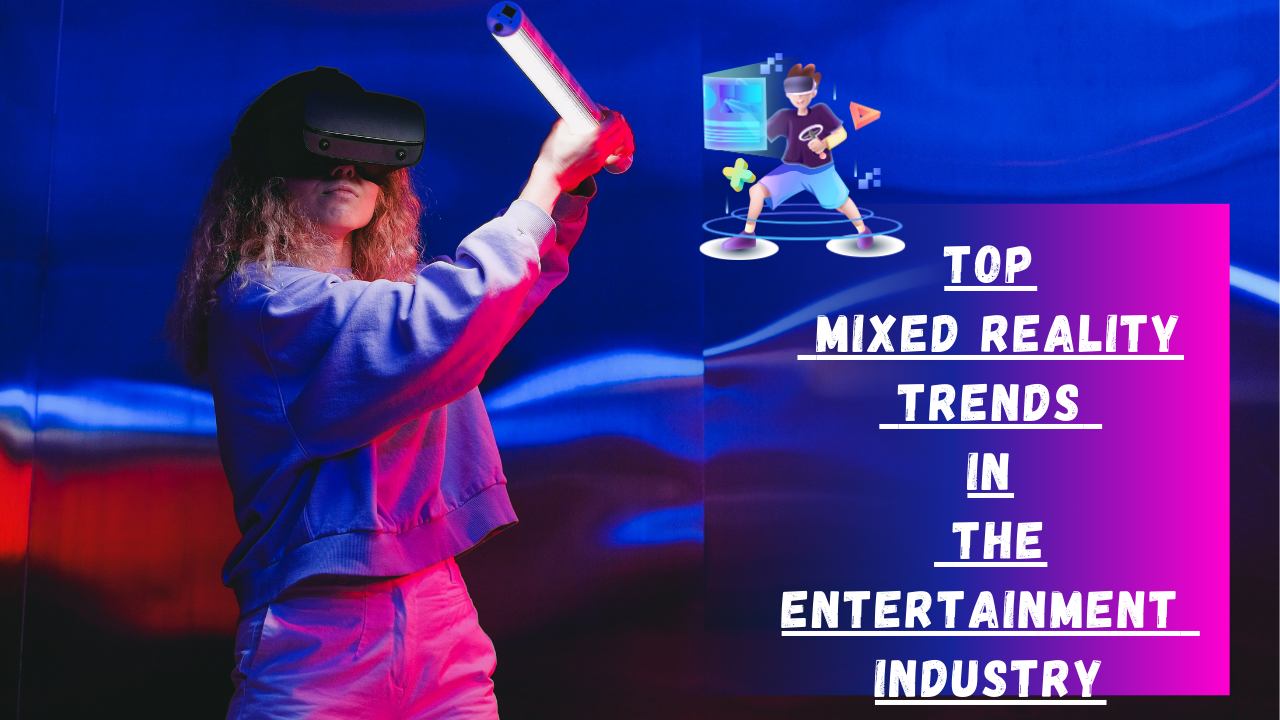Mixed reality (MR) represents a fusion of physical and digital worlds, allowing users to interact with both in real-time. As a technology that encompasses augmented reality (AR) and virtual reality (VR), mixed reality has gained significant traction in the entertainment industry. This article explores the current trends in mixed reality, focusing on how it transforms various facets of entertainment, including gaming, film, live events, and theme parks.
Understanding Mixed Reality
Before diving into its applications in entertainment, it’s essential to understand mixed reality itself. MR combines elements of both AR and VR to create an immersive experience where digital objects coexist with the real world. Users can interact with both physical and virtual elements, offering a more engaging and interactive experience than traditional media.
The Rise of Mixed Reality in Gaming
Immersive Gameplay
One of the most notable trends in MR is its impact on gaming. Traditional gaming experiences have evolved from simple 2D screens to fully immersive environments. Mixed reality gaming platforms, such as Microsoft’s HoloLens and the Magic Leap One, allow players to engage with virtual elements in their physical surroundings. This convergence of digital and physical spaces creates a more immersive gameplay experience, where users can interact with game elements as if they were real.
Social Interaction
MR also enhances social interaction in gaming. Multiplayer games using mixed reality enable players to share the same space and experience the game together, regardless of their physical location. For instance, games like “Pokemon Go” have paved the way for social gaming experiences, where players collaborate to capture virtual creatures in real-world locations. As technology advances, MR gaming is expected to incorporate more sophisticated social features, fostering a sense of community among players.
Storytelling Innovations
MR is revolutionizing storytelling in games. Developers are creating narrative-driven experiences that unfold in real-time, allowing players to influence the storyline through their actions. Games like “Ghostbusters: Dimensions” allow players to step into the shoes of their favorite characters, merging storytelling with interactive gameplay. This trend highlights the potential of MR to create personalized and dynamic narratives that evolve based on player choices.
Transforming Film and Television
Enhanced Viewing Experiences
Mixed reality is also making waves in film and television. Filmmakers are increasingly experimenting with MR technologies to enhance storytelling. By integrating virtual elements into live-action films, directors can create visually stunning experiences that captivate audiences. For example, projects like “The Mandalorian” have utilized LED screens and real-time rendering to create immersive backgrounds, blending live-action with digital environments seamlessly.
Audience Participation
Mixed reality is changing the way audiences engage with content. Interactive storytelling experiences allow viewers to make choices that affect the outcome of the narrative. Platforms like Netflix are exploring this trend with interactive films like “Black Mirror: Bandersnatch,” where viewers can influence the plot through their decisions. This level of interactivity transforms passive viewers into active participants, deepening their connection to the story.
Virtual Film Festivals
The COVID-19 pandemic accelerated the adoption of virtual events, including film festivals. Mixed reality technologies have enabled filmmakers to showcase their work in innovative ways. Virtual film festivals can offer immersive experiences where audiences can interact with the content and participate in discussions with filmmakers in real-time. This trend is likely to continue, offering filmmakers new avenues to reach global audiences.
Live Events and Concerts
Immersive Concert Experiences
Live events, particularly concerts, are increasingly leveraging mixed reality to create unforgettable experiences. Artists are experimenting with MR to enhance performances, providing audiences with interactive visuals and effects that complement the music. For instance, artists like Travis Scott have utilized platforms like Fortnite to host virtual concerts, where fans can engage with the performance in a dynamic and immersive environment.
Hybrid Events
The rise of MR has also led to the emergence of hybrid events that blend physical and virtual experiences. These events allow attendees to participate in person while also offering virtual access to those unable to attend. This trend democratizes access to live events, enabling a broader audience to experience concerts, festivals, and performances regardless of location.
Audience Engagement
MR enhances audience engagement during live events. Attendees can use their smartphones or MR headsets to access additional content, such as behind-the-scenes footage, artist interviews, or interactive experiences related to the performance. This added layer of engagement deepens the connection between artists and their fans, creating a more immersive and memorable experience.
Theme Parks and Attractions
Immersive Experiences
Theme parks are at the forefront of mixed reality innovation. Attractions like “The Wizarding World of Harry Potter” at Universal Studios have integrated MR elements to enhance guest experiences. Visitors can interact with their surroundings through AR apps, casting spells and engaging with digital characters, blurring the line between reality and fantasy.
Queue Management
Mixed reality technologies are also being employed to improve visitor experience in theme parks. MR can facilitate better queue management by providing real-time updates and allowing guests to reserve spots in line virtually. This not only enhances the visitor experience but also optimizes park operations, reducing wait times and improving guest satisfaction.
Educational Opportunities
Some theme parks are utilizing mixed reality for educational purposes. Attractions that focus on science, history, or environmental awareness can use MR to create engaging learning experiences. For instance, visitors can explore virtual ecosystems or historical events, making learning more interactive and enjoyable.
The Future of Mixed Reality in Entertainment
Technological Advancements
As technology continues to advance, mixed reality will become even more integrated into the entertainment industry. Improvements in hardware, software, and connectivity will enable more sophisticated experiences. The development of 5G networks, for instance, will facilitate real-time interactions and high-quality streaming of MR content, making it more accessible to audiences worldwide.
Accessibility and Inclusivity
The future of mixed reality in entertainment also holds promise for accessibility and inclusivity. As MR technologies become more widespread, there is potential for creating experiences that cater to diverse audiences, including those with disabilities. Developers are already exploring ways to make MR content more inclusive, allowing everyone to engage with entertainment in new ways.
Cross-Industry Collaborations
The convergence of various industries will also drive the growth of mixed reality in entertainment. Collaborations between tech companies, filmmakers, game developers, and live event organizers will lead to innovative experiences that push the boundaries of creativity. This interdisciplinary approach will foster new ideas and technologies, enriching the overall entertainment landscape.
Challenges and Considerations
Technical Limitations
Despite its potential, mixed reality faces technical challenges. Current MR devices can be expensive, limiting access for some consumers. Additionally, the technology still has limitations regarding field of view, resolution, and comfort during prolonged use. Addressing these technical challenges will be crucial for widespread adoption.
Content Creation
Creating high-quality mixed reality content requires specialized skills and knowledge. As the industry grows, there will be a demand for talented creators who can design and produce engaging MR experiences. Investing in education and training programs will be essential to cultivate a skilled workforce capable of pushing the boundaries of mixed reality.
User Experience
Ensuring a seamless user experience is vital for the success of mixed reality in entertainment. Content developers must prioritize usability and accessibility to create experiences that are enjoyable for all users. This includes considering factors such as comfort, ease of use, and intuitive interfaces.
The Role of Artificial Intelligence in Mixed Reality
Artificial intelligence (AI) is increasingly becoming a key player in enhancing mixed reality experiences across the entertainment industry. By leveraging AI, developers can create more adaptive and intelligent environments that respond to user interactions in real-time. For instance, in gaming, AI can analyze player behavior to tailor challenges, environments, and narratives to individual preferences, resulting in a personalized gaming experience. In film and live performances, AI can facilitate interactive storytelling, where characters can respond dynamically to audience choices, creating a unique narrative journey for each viewer. This integration of AI not only enriches the user experience but also opens up new creative avenues for content creators.
Ethical Considerations and Privacy Concerns
As mixed reality becomes more integrated into entertainment, ethical considerations, and privacy concerns are gaining prominence. The collection and analysis of user data to enhance experiences raise questions about consent and data security. For example, gaming and interactive applications often require access to personal information and real-world location data, which can be sensitive. Developers must prioritize transparency and user control over data collection practices to build trust with their audiences. Furthermore, the potential for mixed reality to create hyper-realistic experiences blurs the lines between fiction and reality, leading to concerns about misinformation and its impact on societal perceptions. Addressing these ethical challenges is crucial to ensuring that mixed reality can be enjoyed safely and responsibly in the entertainment landscape.
Conclusion
Mixed reality is transforming the entertainment industry, offering innovative ways to engage audiences and create immersive experiences. From gaming and film to live events and theme parks, the integration of MR technologies is reshaping how we consume and interact with entertainment. As advancements continue and challenges are addressed, mixed reality is poised to play a significant role in the future of entertainment, fostering creativity, inclusivity, and engagement in ways we have yet to imagine. The trends we are witnessing today are just the beginning of a new era in entertainment, one where the lines between the physical and digital worlds continue to blur, inviting us to explore new realms of possibility.
FAQs
What is mixed reality (MR)?
Mixed reality (MR) is a technology that combines elements of both augmented reality (AR) and virtual reality (VR) to create interactive environments where physical and digital objects coexist and can be interacted with in real-time.
How is mixed reality used in gaming?
Mixed reality enhances gaming by allowing players to interact with virtual elements in their physical environment. Games like “Pokemon Go” and “Beat Saber” offer immersive experiences where players can engage with digital characters and objects as if they were part of the real world.
What are some examples of mixed reality in film and television?
Filmmakers are using MR to create more engaging storytelling experiences. For instance, productions like “The Mandalorian” utilize real-time rendering and digital backgrounds, allowing for a seamless blend of live-action and virtual elements.
How does mixed reality improve live events and concerts?
Mixed reality enhances live events by providing immersive visuals and interactive experiences. Artists can create virtual concerts, allowing fans to participate from anywhere, while also offering added content through MR apps that engage the audience during performances.
What trends are shaping the future of mixed reality in entertainment?
Key trends include the integration of artificial intelligence for personalized experiences, the rise of hybrid events that combine in-person and virtual attendance, and a growing focus on inclusivity and accessibility for diverse audiences.
